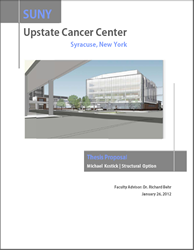Thesis Proposal |
The Capstone Project Electronic Portfolio (CPEP) is a web-based project and information center. It contains material produced for a year-long Senior Thesis class. Its purpose, in addition to providing central storage of individual assignments, is to foster communication and collaboration between student, faculty consultant, course instructors, and industry consultants. This website is dedicated to the research and analysis conducted via guidlines provided by the Department of Architectural Engineering. For an explanation of this capstone design course and its requirements click here. |
|
Proposal - Structural Depth |
| |
The structural depth for this thesis will be to redesign the structural system of the SUNY Upstate Cancer Center in Syracuse, New York. Reinforced concrete will replace the existing structural steel superstructure, as the building's gravity and lateral load resisting systems will be redesigned. The primary objective of this thesis will be to study the concepts of progressive collapse design. Once the preliminary redesign is complete, critical members will be selected and designed to meet progressive collapse requirements established by the Unified Facilities Criteria and the General Services Administration.
Click the bottom thumbnail to view a PDF of the Original Proposal.
To view a copy of the Updated Proposal, click the middle thumbnail. Changes include minor grammatical alterations and a complete overahaul to Breadth Topic 1.
To view the most Current Proposal, click the top thumbnail. |
|
|
Breadth 1 - Site Architecture: Risk Mitigation Site Redesign |
| |
Maintaining the progressive collapse theme, the existing building site will be redesigned incorporating features and tactics to help diminish or eliminate potential threats such as explosions and vehicular impacts. Increasing stand-off distance, placing barriers, and utilizing energy deflection/absorption shields are some of the strategies which will be explored through this breadth study. This preventative approach accompanied with the structural modifications will create a thorough design to resist progressive collapse. |
|
|
Breadth 2 - Building Enclosure: Building Envelope Study |
| |
Currently there is a full height glass curtain wall that faces the north-east facade of the building. The second breadth topic will consist of a heat transfer analysis of the glass curtain wall to evaluate its efficiency. An alternative curtain wall system will be developed with intentions of optimizing energy efficiency and sustainability. In addition, the newly proposed curtain wall will be designed to be blast resistant, supplementing the Risk Mitigation Site Redesign breadth. The new and existing systems will then be compared for their effectiveness. |
|
|
MAE Requirements |
| |
Knowledge obtained from AE 597A, Computer Modeling of Building Structures, will be used to create an ETABS model to supplement the design process by determining member forces. AE 542, Building Enclosure Science and Design, will be largely used in the evaluation and redesigning of the glass curtain wall facade. |
|
|
|
 |
Current Proposal - Posted 1/29/12 |
 |
Updated Proposal - Posted 1/13/12 |
 |
Original Proposal - Posted 12/9/11 |
|
|



